

Noise Music / Music Forum. Image to Sound Mapping [Part 1] « The vOICe Home Page Page contents: Principles and frequency distributions The above figure illustrates the principles of the conversion procedure for the simple example of an 8 × 8, 3 grey-tone image (instead of the 64 × 64, 16 grey-tone mapping that we use in reality).
![Image to Sound Mapping [Part 1]](http://cdn.pearltrees.com/s/pic/th/image-to-sound-mapping-part-1-42930983)
The mapping translates, for each pixel, vertical position into frequency, horizontal position into time-after-click, and brightness into oscillation amplitude. It may take one or two seconds to convert the whole pixel matrix into sound. Many other types of frequency distribution could be used for an auditory display. The following template allows you to obtain lists of frequencies and frequency steps for several types of frequency distribution, and you can override several of the default parameter settings: Artificial scenes with FREE SOFTWARE For this particular auditory scene, the sound was synthesized off-line by a computer program (source code in ANSI C). Relations with other work Copyright © 1996 - 2014 Peter B.L. AudioZ - Professional Audio Software Community. Sum & Difference Monitoring - Reverse Engineering! Have you ever considered using Sum & Difference monitoring techniques to enable you to reverse engineer some of your favourite records?
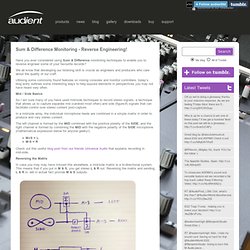
We all know that developing our listening skill is crucial as engineers and producers who care about the quality of our craft. Utilising some commonly found features on mixing consoles and monitor controllers, today’s blog entry outlines some interesting ways to help expose elements in perspectives you may not have heard very often. Mid / Side Basics So I am sure many of you have used mid/side techniques to record stereo signals, a technique that allows us to capture separate mid (cardioid most often) and side (figure-8) signals that can facilitate control over stereo content post-capture.
In a mid/side array, the individual microphone feeds are combined in a simple matrix in order to produce and vary stereo content. Home Page.
Izotope RX2 Tutorials for Post Production. Mixing. Tele-Present Water by David Bowen visualizes intensity and movement of the water in a remote location #maxmsp #arduino. Created by David Bowen, Tele-Present Water installation draws information from the intensity and movement of the water in a remote location.
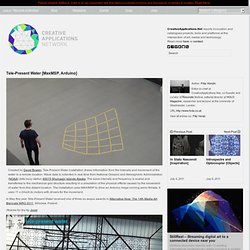
Wave data is collected in real-time from National Oceanic and Atmospheric Administration (NOAA) data buoy station 46075 Shumagin Islands Alaska. The wave intensity and frequency is scaled and transferred to the mechanical grid structure resulting in a simulation of the physical effects caused by the movement of water from this distant location. The installation uses MAX/MSP to drive an Arduino mega running servo firmata. It uses 11 x 24volt dc motors with drivers for the movement.
In May this year Tele-Present Water received one of three ex aequo awards in Alternative Now: The 14th Media Art Biennale WRO 2011, Wroclaw, Poland. //thanks for the tip Joost 11 x 24volt dc motors. HTG Explains: What Are the Differences Between All Those Audio Formats? Digital audio has been around a very long time so there’s bound to be a plethora of audio formats out there.
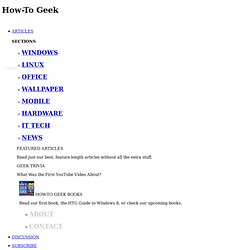
Here are some of the more common ones, what differentiates them, and what to use them for. Before we talk about everyday audio formats, it’s important you understand the basics, and that means understanding PCM. After that, we’ll tackle compressed formats. PCM Audio: Where It All Starts Pulse-Code Modulation was created back in 1937 and is the closest approximation of analog audio. True sound, in the real world, is continuous. Image from Wikipedia I know there’s a lot here that may not be second-nature unless you’re an engineer, physicist, or an audiophile, so let’s pare it down further with an analogy. Let’s say that the water flowing from an open faucet is your “analog” audio source. Bit depth is a little trickier. As previously mentioned, PCM is the foundation for digital audio, along with its variants.
The Uncompressed Bunch: WAV, AIFF. Designing Sound. Free and donationware music plugins. Build an Infrasonic Subwoofer. ObiAudio. This is from a thread on Future Producers..I did not write this and do…to an extent…agree with most of this.

I just copied and pasted the good stuff: To understand EQ and its intricacies you need hands-on experience, but to help you get started, here’s a table of general uses and the different ranges that EQ can affect. As every sound is different, though, these are necessarily very general guidelines… Kick Drum. Otomata. 16 Jul 2011 Click on the grid below to add cells, click on cells to change their direction, and press play to listen to your music.
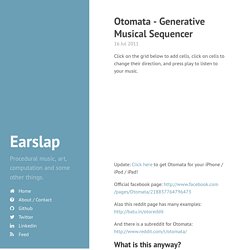
Lesson Plan for Making a Speaker Laboratory. ©1995 The Regents of the University of California.

- Understanding DC-Offset. This Vocal Technique Will Improve Your Voice Dramatically. Music evolution: Is this the end of the composer? 18 June 2012Last updated at 20:47 ET By Rebecca Morelle Science reporter, BBC News Professor Armand Leroi from Imperial College London explains why he thinks a Darwinian computer program that can evolve music from noise could kill off the composer You might think that creating the perfect piece of music - whether it's a classical great, jazz masterpiece or pop hit - is all down to the composer's talent, flair or even genius.
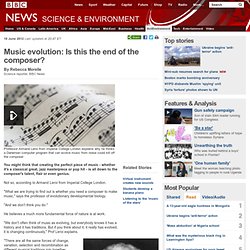
Not so, according to Armand Leroi from Imperial College London. "What we are trying to find out is whether you need a composer to make music," says the professor of evolutionary developmental biology. Play the Rings of a Tree Trunk Like a Record. The Loudness War: Why Music Sounds Worse // Current.
Sound and Sound Reproduction: a conversation with Gareth Jones - Ubelly.